
News
Ingrid Boas Wins Wrigley Fairchild Award for her Critical Paper on Big Data
This year's prestigious Wrigley Fairchild Award for best paper in the journal Geographical Review goes to Dr Ingrid Boas, Associate Professor in the Environmental Policy Group of Wageningen University, and co-authors Ruben Dahm (Deltares) and David Wrathall (Oregon State University). Together they wrote Grounding Big Data on Climate-Induced Human Mobility, a paper about the risks and benefits of big data for climate mobility. “Big data can be useful, but we should not jump to conclusions.”
Boas has been working on the topic of climate, migration, and mobility since 2007. She became interested in this topic because of the framing of climate migration. “I prefer to call it climate mobility,” she says. “Because the idea of a stream of migrants travelling across continents to Europe because of climate change incorrect. I have done research in areas affected by climate change and other environmental problems, such as Bangladesh, India, and Kenya. The inhabitants sometimes move a bit when their land is affected, or move to a town or country nearby, but they often return too. It usually concerns small movements.”
Data Without Context
During her work, she came across a big data study by David Wrathall that he did together with Xin Lu and many others. Using anonymous mobile phone data from Bengal, they hypothesised in their research that, during Hurricane Mahasen in 2013, the people of southern Bangladesh had evacuated the area in large numbers. “That study, even though it was based on a hypothesis, greatly reinforced the view that climate change leads to displacement and forced migration,” says Boas. “It is still used today, in conferences, meetings with NGOs, or the United Nations. But the hypothesis is wrong. The observed movements were not people fleeing, but fishers going to their boats to protect them from the water and to guard them.”
Boas discovered this when she went to Bangladesh for additional field research.“Together with Ruben Dahm and David Wrathall, we produced a new paper,” she says. “One that shows that big data should always be combined with field research and interviews. You cannot simply draw random conclusions from it and present them in a nice figure: you end up with a picture without any context that way. We have to find out what happened first.”
Combining Research and Listening to Inhabitants
During the research for the winning paper, Boas interacted with the Bengalis. “It was suprising when it turned out that no big-data analysis of telecommunications was available for the area that had been worst hit by the hurricane.” No movement was detected there via mobile phones. There, affected groups had gone into high-rise school buildings and residents climbed onto the roofs of their houses. “It was a very dangerous situation there, but the data didn't say anything about it.” These movements all happened near the same telephone tower, so it did not show up in the big-data analysis.
The latter area was more severely flooded during the hurricane, as an important embankment had gradually eroded away over many years. “When we started to investigate this erosion further, big data turned out to be useful again. Dahm collected satellite images of the erosion over a long period of time. We showed videos of this to the residents during our interviews.” This triggered many residents to join in and together they investigated the impact of the erosion. “With the images, they could remember more about how exactly their village has changed over time, which made our research better and more structured.”
Boas therefore advocates mutual collaboration. “See if you can join other researchers. Find existing research on the areas you are writing about. Also, you should not work purely based on assumptions: be open to new insights instead. Do not use leading questions during field research. Reflect on your hypothesis.”
Addressing the Right Issues
Big data is a convenient way to get a lot of information quickly. But drawing conclusions from this too quickly is, in Boas' opinion, a “dangerous trend”. “On the one hand, because you don't know what it shows and, on the other hand, because it can lead to a misrepresentation of the issue questions and understandings. When climate refugees are framed as coming our way in large numbers, we talk about it as how it is going to affect us. This does not do justice to the affected inhabitants. They most likely want to stay there, try to return, and build something new. They could use support to protect their boats or to build up new businesses that fit in well with the new climate reality. Or if the affected inhabitants have or want to leave, they often move to nearby villages or towns where they already have connections. To be able to provide support for this and offer people appropriate protection, you need to know what is really going on. Climate migration is currently being talked about in far too simplistic a way.”
The Geographical Review prize will be awarded next year (subject to COVID-19 restrictions) at the annual conference of The American Association of Geographers in New York. Boas conducted her research as part of the Veni grant, which she received from the Netherlands Organisation for Scientific Research.